
Explore Flanders Fields: Visit the CWGC in Ieper, Belgium
Info centre - Gift Shop - Cafe
Right beside the iconic Menin Gate, our Ieper Visitor Centre welcomes you to a place where history lives on. Known as ‘Wipers’ by British troops, Ieper, also known as Ypres, saw fierce fighting over a century ago. Today, we’re here to help you explore the legacy of the Fallen and discover the stories that still echo across the landscape.
Remembrance and Winter in Ieper
We are extending our opening hours during Remembrance. From 8 to 11 November, the centre will be open from 10am to 9pm.
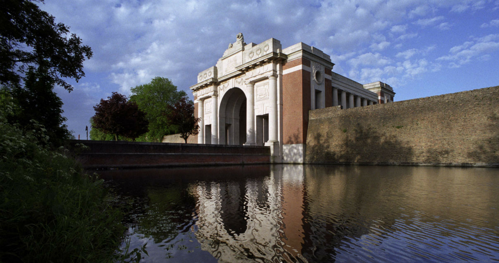
Menin Gate For Evermore Guided Walk
Join our special guided walk and uncover the stories behind the iconic Menin Gate Memorial. A moving experience that brings remembrance to life.

Coff’tails at the Visitor Centre
Warm up with our winter-themed Coff’tails, a cosy blend of coffee and cocktails served with a smile.

Limited Edition CWGC Chocolate
Indulge in our exclusive CWGC chocolate, crafted in Belgium and available only this season. A sweet tribute to remembrance.

Win a Limited Edition Tea Caddy
Take part in our winter giveaway and stand a chance to win a beautiful Menin Gate tea caddy.
Your journey to VISITING Ypres Battlefields begins here
Our new visitor centre stands at the heart of commemoration in Belgium directly across from the Menin Gate. It forms the perfect starting point when visiting the WW1 battlefields and the cemeteries and memorials where those who fell are today commemorated. Our multi-language team are on hand. You can:

Talk to our team and learn more about the work of our dedicated teams of craftsmen and gardeners in Belgium and around the world. Our multi-language colleagues are happy to share the Best WW1 battlefields to visit.

Research your family history using the CWGC database. Whether you're tracing a relative or starting a new project, we’re here to help you find the graves and stories you’re looking for.

Join one of our activities, hear the stories of the Fallen, attend a book launch, take part in guided tours or learn how to research a soldier yourself in our workshops.

Take a moment to reflect in our café, where we serve Taylor of Harrogate teas and freshly baked British cakes.

Take home a carefully chosen, limited edition souvenir—available only in our CWGC shop. Each item tells a story and serves as a lasting reminder of your visit.

Reserve a biodegradable wreath to lay at a headstone or the Last Post ceremony.
All proceeds support our global educational and outreach work, helping ensure the stories of the Fallen are never forgotten.

Get your Biodegradable wreath
Our wreaths, handmade locally using natural plant life that grows across Flanders Fields, are the perfect way to pay tribute to the fallen of the world wars.
Purchase your wreath and take it with you to the Last Post ceremony. If you're visiting us earlier in the day, we're happy to hold your wreath for you, and you can pick it up ahead of the ceremony.
Would you like to reserve your biodegradable wreath before your visit?
Large - €45 / Medium - €25 / Small - €6
Opening Hours
1 pm – 9 pm
Closed
1 pm – 9 pm
1 pm – 9 pm
1 pm – 9 pm
1 pm – 9 pm
1 pm – 9 pm
On significant days when specific important historical events are commemorated, extended opening hours are possible.
We are dedicated to offering an inclusive experience, ensuring that all visitors, including those with disabilities, can fully enjoy our centre. Wheelchair access is available to the left of the main entrance.
If you have any questions, or to arrange any added support for your visit please email enquiries@cwgc.org or call us on +32 (0) 5722 4750.
Travelling to Ieper
Our address is:
The Commonwealth War Graves Commission Visitor Information Centre
Menenstraat 46, 8900 Ieper, Belgium
 By Car
By Car
From Lille: take the A25 to exit 13 and join the D948.
From Calais: take the A16 to Dunkirk and Lille and pick up the Lille route.
 By train
By train
Eurostar from London to Lille or Brussels. From Brussels, trains run hourly to Ypres with a change in trains in Ghent. From Lille Europe, you would need to change stations to Lille Flanders (by foot) and change trains as well in Kortrijk.
 BY FERRY/CHANNEL TUNNEL:
BY FERRY/CHANNEL TUNNEL:
Ferry services to Calais, Le Shuttle service to Calais.
 BY AIR:
BY AIR:
Lille airport in Lesquin or Brussels International.
Find us - Ieper Belgium Map
EXPLORE CWGC IEPER / YPRES WAR GRAVES AND SITES
The trench warfare around the Ypres Salient cost thousands of lives on both sides. Many of our largest cemeteries and memorials can be found in the Flanders region. Some of the closest sites to the town are:

The Ypres Menin Gate Memorial
The Menin Gate in Ieper is one of the most famous war memorials in the world. Unveiled on 24 July 1927, the memorial bears the names of more than 54,000 officers and men from around the Commonwealth who died in the region and have no known grave.

New Irish Farm Cemetery
Located to the north-east of the town, New Irish Farm cemetery is the final resting place of more than 4,700 Commonwealth servicemen of World War One who were brought to the site from battlefield burials and smaller cemeteries in the region.

HOOGE CRATER CEMETERY
Named after the nearby Hooge Chateau and a crater caused by a mine explosion, Hooge Crater Cemetery is located in an area that saw incredibly fierce fighting throughout the duration of the war. Close to 6,000 World War One burials can be found here, more than half of which remain unidentified.

BEDFORD HOUSE CEMETERY
There are more than 5,000 World War One burials at Bedford House Cemetery, as well as 69 World War Two burials. It is named after the Chateau Rosendal, which was named Bedford House by Commonwealth troops stationed nearby.
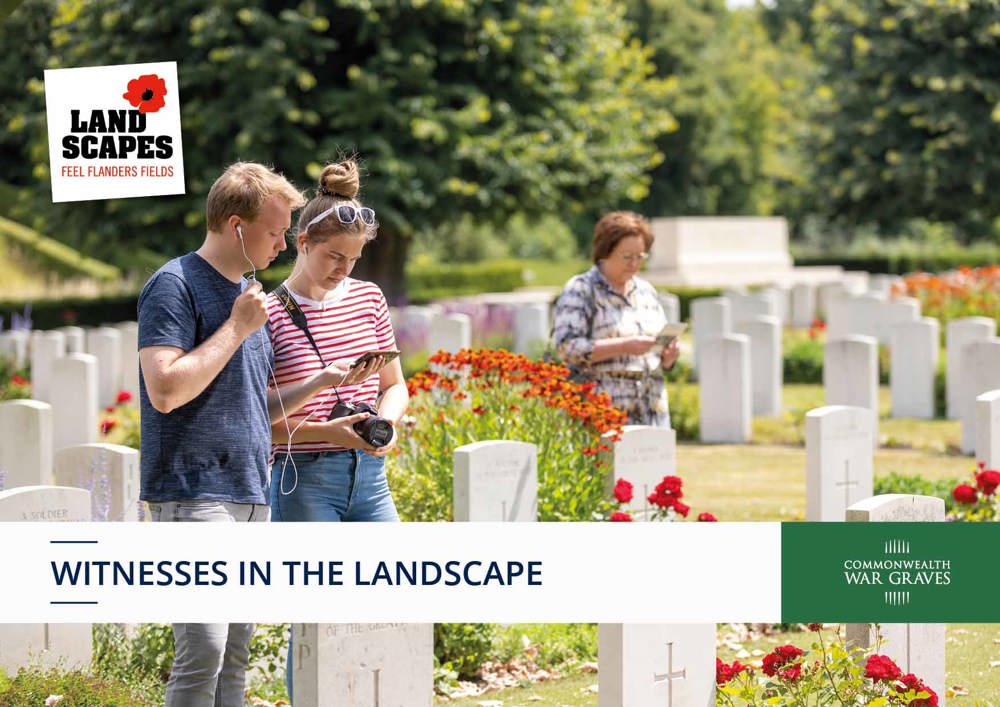
Ypres war memorial tours with Westtoer
If you want to explore the Ypres salient but aren’t sure where to start, try building your own Flanders pilgrimage using our self-guided tours. Browse our range of downloadable guides on the local cemeteries and memorials in and around Ieper or try our themed recommendations.
Things to do in Ieper
As well as its ties to the world wars, Ieper has a rich cultural and historical character. There is a huge array of places to see and things to do in Ypres:
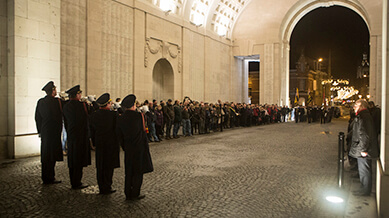
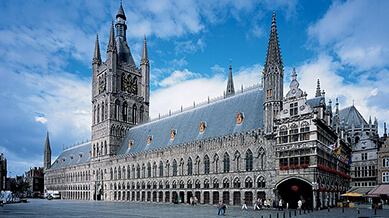
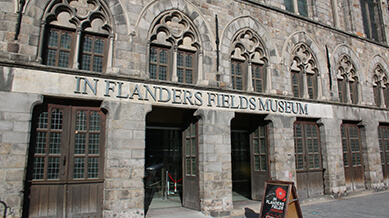
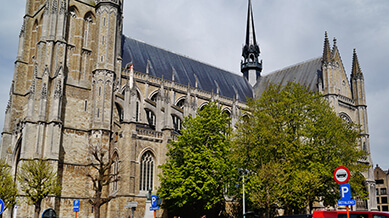
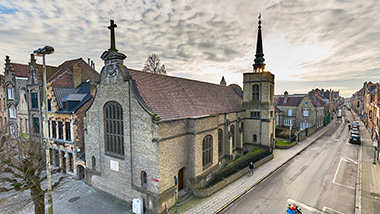

The history of Ieper

Ypres was a key strategic point in the front lines having been captured by the British army during the opening months of the war. This advance caused a bulge in the line, known as the Ypres Salient, which was the site of many of the fiercest battles of the war.
Today, the town of Ypres has been rebuilt but still retains its ties to the war. Ieper is home to the iconic Menin Gate Memorial to the Missing and a number of other CWGC war cemeteries and memorials throughout the region.
Where is Ypres?
Ypres, or Ieper, is a small city in the province of West Flanders, Belgium.
The city is close to the France-Belgian border and was the last line of defence against the German push to the French ports of Calais and Dunkirk, which were a vital part of the supply lines between Britain and the Western Front.
Why is Ypres called Ieper?
Simply put, Ypres is the French language name for the town, and Ieper is the Dutch language name for the town.
Today, Ieper is the official name, but during World War One, British soldiers would use Ypres, although anglicised to “Wipers” - as notably demonstrated by the soldiers’ publication ‘The Wipers Times’.
Ypres and WW1
The battles at Ypres and the surrounding areas have become synonymous with the trench warfare that typified the fighting on the Western Front.
The First Battle of Ypres began in October 1914, as the opposing forces attempted to outflank one another, with neither side able to gain a decisive advantage. The German forces wanted to push through Belgium and into northern France, whilst the Allied troops' armies sought to hold the channel ports and preserve their important supply routes with the United Kingdom. The battle drew to a stalemate as the weather worsened, ending on 22 November 1914, although a few ineffective operations were launched throughout the winter months.
The Second Battle of Ypres began in April 1915 when German forces attacked Allied lines in the north of the Ypres Salient, an area where Allied lines were surrounded on three sides by German-held territory. The battle was notable for one of the earliest uses of poison gas by German forces. The Allied defenders were pushed 3 miles closer to Ypres, although they retreated a German breakthrough did not materialise.
The Third Battle of Ypres, also known as the Battle of Passchendaele, began in July 1917, lasting for more than three months before it ended in November 1917. In what was one of the bloodiest battles of the war, the Allies made an initially successful assault, before becoming bogged down by bad weather and strong German defences.
In drier weather in September and October, British Empire forces achieved success with limited attacks intended to ‘bite and hold’ German lines. South African, Australian, New Zealand and Canadian forces would all play an important role.
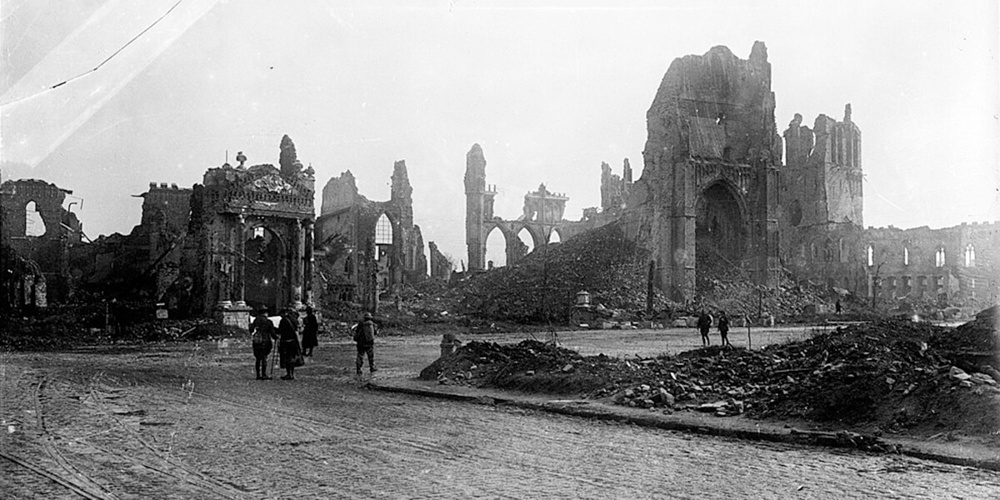
German forces suffered heavy casualties during the battles of the Menin Road Ridge, Polygon Wood and Broodseinde. In October, heavy rain returned and turned the Ypres battlefields into a muddy morass during further fighting at Poelcappelle and Passchendaele. The offensive was finally halted after the capture of Passchendaele in November, and the village would lend its name to popular descriptions of the battle.
Throughout the long years of fighting, the city of Ypres - including its historic cathedral and Cloth Hall - was turned to rubble by German artillery. In 1920, King George V awarded the Military Cross to the city, which also received the French Croix de Guerre. While the city has since been rebuilt, the scars of the Great War are still evident, with many WW1 cemeteries, memorials and monuments to those that died.
Ieper / YPRES war memorials
Such was the ferocity of the fighting around the Ypres salient, that many of our largest and most well known cemeteries and memorials can be found in or nearby Ieper.
One of the most famous war memorials in the world, the Ypres Menin Gate, is a key part of the city and home to the nightly Last Post service, where residents and visitors to the city pay tribute to all those who died during the war.
The CWGC’s New Irish Farm cemetery, Hooge Crater Cemetery and Bedford House Cemetery are located on the outskirts of the city, all of which hold thousands of First World War casualties, and the Tyne Cot Cemetery and memorial can be found just a short drive from the city.
Learn more about the cemeteries and memorials in Ypres.

Ieper, seen through the Menin Gate at night, (photo: Dirk Debleu)
YPRES (MENIN GATE) MEMORIAL RESTORATION
The iconic Menin Gate Memorial is currently undergoing an extensive restoration programme in readiness for its centenary in 2027.








